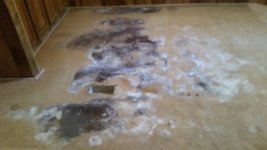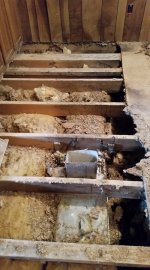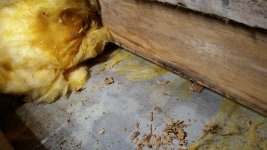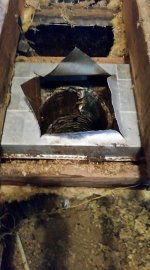EddieWalker
Epic Contributor
This is something new to me. I have a client who owns an older double wide mobile home with some soft spots in her floor. Normally this is a pretty simple repair, I remove the carpet, cut out the bad area of particle board and install new particle board. When I pulled up the carpet, I saw this!!!

I removed some of the wood and realized that the mold and rot was fallowing the path of the HVAC duct under the floor

Then I felt the top of the duct and found it to be wet. Some spots where so wet that the insulation around the duct would drip water.

So my first thought was there is a leak somewhere. On the other side of the wall is a bathroom. The vanity is right over the duct, so I removed the vanity, cut a hole in the floor and found learned that the duct there is totally dry, and the only pipe that crosses over the duct is the sink drain line, which is also perfectly dry. That was a waste of time, but at least we know it's not the problem.
I removed more of the sub floor and opened up the area so I could get under it and discovered that their is a big air vent line coming from the other side of the mobile home to this side. It's a big flex line, maybe 15 inches. It comes along the ground and then straight up into the bottom of the metal duct that you see in the pictures. The metal is very thin. I cut it with my sheetrock knife. The insulation around the metal duct is also very thin.

If I was to guess, I think that the moisture is thickest, or heaviest at the point where the big duct comes into the metal line, and then goes left to right. I think that the cold air hitting the metal causes condensation on the outside of the metal duct. It is wet on the bottom too, but not as much. I think the moisture on the bottom drops to the dirt below, but it's so dry under there I can't prove that. I think that the moisture on the top has slowly spread out, down along the top of the duct. The joists show wet staining where the duct touches the insulation on top of the duct. Over time, the moisture has led to the particle board growing mold, and then rotting.
Does that makes sense, or am I way off base?
My solution is to super seal up any holes that might be in the fitting that connects the flex supply line to the metal duct. Then I plan to use expanding foam between the 2x6 floor joists and the metal duct. There is about a half inch gap there after I removed the insulation. Then I will cut and fit 3/4 inch Styrofoam boards on top of the metal duct, then R19 insulation of top of the foam with the vapor barrier facing down.
Will this stop the condensation from forming? Will this protect the new 3/4 inch plywood that I'm going to put down instead of the 5/8 particle board that was there?
What else can I do, or what should I do instead?
Thanks, I'm struggling with trying to make this right without any real experience. Every AC guy I know, I called, and they all said that they have never seen this before, only water build up inside the ducts from dirty coils.

I removed some of the wood and realized that the mold and rot was fallowing the path of the HVAC duct under the floor

Then I felt the top of the duct and found it to be wet. Some spots where so wet that the insulation around the duct would drip water.

So my first thought was there is a leak somewhere. On the other side of the wall is a bathroom. The vanity is right over the duct, so I removed the vanity, cut a hole in the floor and found learned that the duct there is totally dry, and the only pipe that crosses over the duct is the sink drain line, which is also perfectly dry. That was a waste of time, but at least we know it's not the problem.
I removed more of the sub floor and opened up the area so I could get under it and discovered that their is a big air vent line coming from the other side of the mobile home to this side. It's a big flex line, maybe 15 inches. It comes along the ground and then straight up into the bottom of the metal duct that you see in the pictures. The metal is very thin. I cut it with my sheetrock knife. The insulation around the metal duct is also very thin.

If I was to guess, I think that the moisture is thickest, or heaviest at the point where the big duct comes into the metal line, and then goes left to right. I think that the cold air hitting the metal causes condensation on the outside of the metal duct. It is wet on the bottom too, but not as much. I think the moisture on the bottom drops to the dirt below, but it's so dry under there I can't prove that. I think that the moisture on the top has slowly spread out, down along the top of the duct. The joists show wet staining where the duct touches the insulation on top of the duct. Over time, the moisture has led to the particle board growing mold, and then rotting.
Does that makes sense, or am I way off base?
My solution is to super seal up any holes that might be in the fitting that connects the flex supply line to the metal duct. Then I plan to use expanding foam between the 2x6 floor joists and the metal duct. There is about a half inch gap there after I removed the insulation. Then I will cut and fit 3/4 inch Styrofoam boards on top of the metal duct, then R19 insulation of top of the foam with the vapor barrier facing down.
Will this stop the condensation from forming? Will this protect the new 3/4 inch plywood that I'm going to put down instead of the 5/8 particle board that was there?
What else can I do, or what should I do instead?
Thanks, I'm struggling with trying to make this right without any real experience. Every AC guy I know, I called, and they all said that they have never seen this before, only water build up inside the ducts from dirty coils.